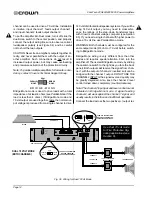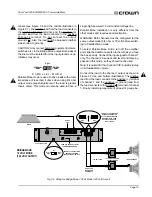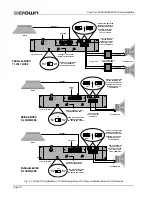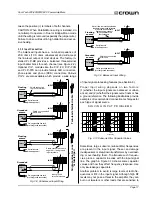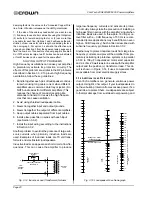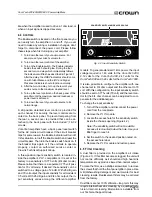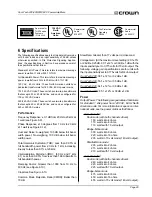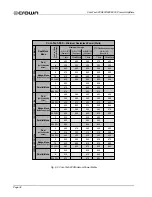
Page 25
Com-Tech 200/400/800/1600 Power Amplifiers
like when the amplifier is used to drive a 1 ohm load, or
when an input signal is clipped severely.
4.4 Controls
The
Enable switch
is located on the front panel so you
can easily turn the amplifier on and off. If you ever
need to make any wiring or installation changes, don’t
forget to disconnect the power cord. Please follow
these steps when first turning on your amplifier:
1. Turn down the level of your audio source. For
example, set your mixer’s volume to –
.
2. Turn down the level controls of the amplifier.
3. Turn on the Enable switch. The Enable indicator
beside the switch should glow. During the four
second turn-on delay which immediately follows,
the indicators will flash as described in Figure 4.1.
After the delay, the
ODEP indicators should come
on with full brilliance and the
IOC and Signal
Presence Indicators should function normally.
4. After the turn-on delay, turn up the level of your
audio source to the maximum desired level.
5. Turn up the level controls on the back panel of the
amplifier until the maximum desired loudness or
power level is achieved.
6. Turn down the level of your audio source to its
normal range.
A 22-position detented
level control
is provided for
each channel. For security, the level controls are lo-
cated on the back panel. To prevent tampering from
the rear, a Lexan cover is provided that can be at-
tached to the back panel with the included
1
¦
2
" 8-32
screws.
Com-Tech amplifiers have a back panel
reset switch
for the AC mains circuit breaker. If the circuit breaker
trips for some reason, the Enable indicator will turn off.
In this situation, turn off the Enable switch and reset the
circuit breaker. Then turn the Enable switch back on. If
the breaker trips again or if the unit fails to operate
properly, contact an authorized service center or
Crown’s Technical Support Group.
A three-position
input sensitivity switch
is located in-
side the amplifier’s
P.I.P. compartment. It is set at the
factory to a sensitivity of 0.775 volts (8/4 ohm mode).
Please notice that there is a separate 0.775 volt posi-
tion for 70 volt mode. If desired, the sensitivity can be
switched to a voltage gain of 26 dB. With 26 dB gain
and 70 volt output, the input sensitivity for all models is
3.5 volts. With 26 dB gain and 8/4 ohm output, the in-
put sensitivity varies among the different amplifier
0.77 V
sensitivity
8/4 ohm
26 dB
gain
SENSITIVITY SWITCH INSIDE ACCESS HOLE
0.77 V
sensitivity
70 volt
THIS AMPLIFIER IS EQUIPPED WITH SELECTABLE INPUT SENSITIVITY. REMOVE P.I.P. MODULE TO ACCESS SENSITIVITY SWITCH.
0
dB
.5
1
2
3
4
5
6
7
8
9
10
11
13
15
17
19
21
25
32
∞
0
dB
.5
1
2
3
4
5
6
7
8
9
10
11
13
15
17
19
21
25
32
∞
CH-2
CH-1
INPUT ATTENUATION
Fig. 4.2 Input Sensitivity Switch
models. To generate standard 1 kHz power, the input
voltage required is 1.48 volts for the
Com-Tech 200,
2.12 volts for the
Com-Tech 400, 2.47 volts for the
Com-Tech 800 and 3.29 volts for the Com-Tech 1600.
It is also possible to configure the amplifier with one
channel set to 8/4 ohm output and the other set to 70
volt. With this configuration, the input sensitivity switch
should be set to 0.775 volts (70 volt), and the level con-
trol for the 8/4 ohm channel can be adjusted to com-
pensate for the additional gain.
To change the input sensitivity:
1. Turn off the amplifier and disconnect the power
cord from the receptacle.
2. Remove the
P.I.P. module.
3. Locate the access hole for the sensitivity switch
inside the chassis opening (Figure 4.2).
Note: The sensitivity switch will not be visible
because it is mounted below the hole. Use your
little finger to reach it.
4. Set the switch to the desired position noted on
the access hole label.
5. Replace the
P.I.P. module and restore power.
4.5 Filter Cleaning
A dust filter is provided on the amplifier’s air intake
(Figure 2.1). If this filter becomes clogged, the unit will
not cool as efficiently as it should and high heat sink
temperatures may produce lower-than-normal output.
To clean the filter, use a phillips screwdriver to remove
the screws that hold the front panel grille in place. Use
mild dishwashing detergent and warm water for best
cleaning results. Replacement filters may be ordered
from the factory.
Dust filters are not 100% efficient—long term this may
require internal heat sink cleaning by a qualified tech-
nician. Internal cleaning information is available from
our Technical Support Group.




